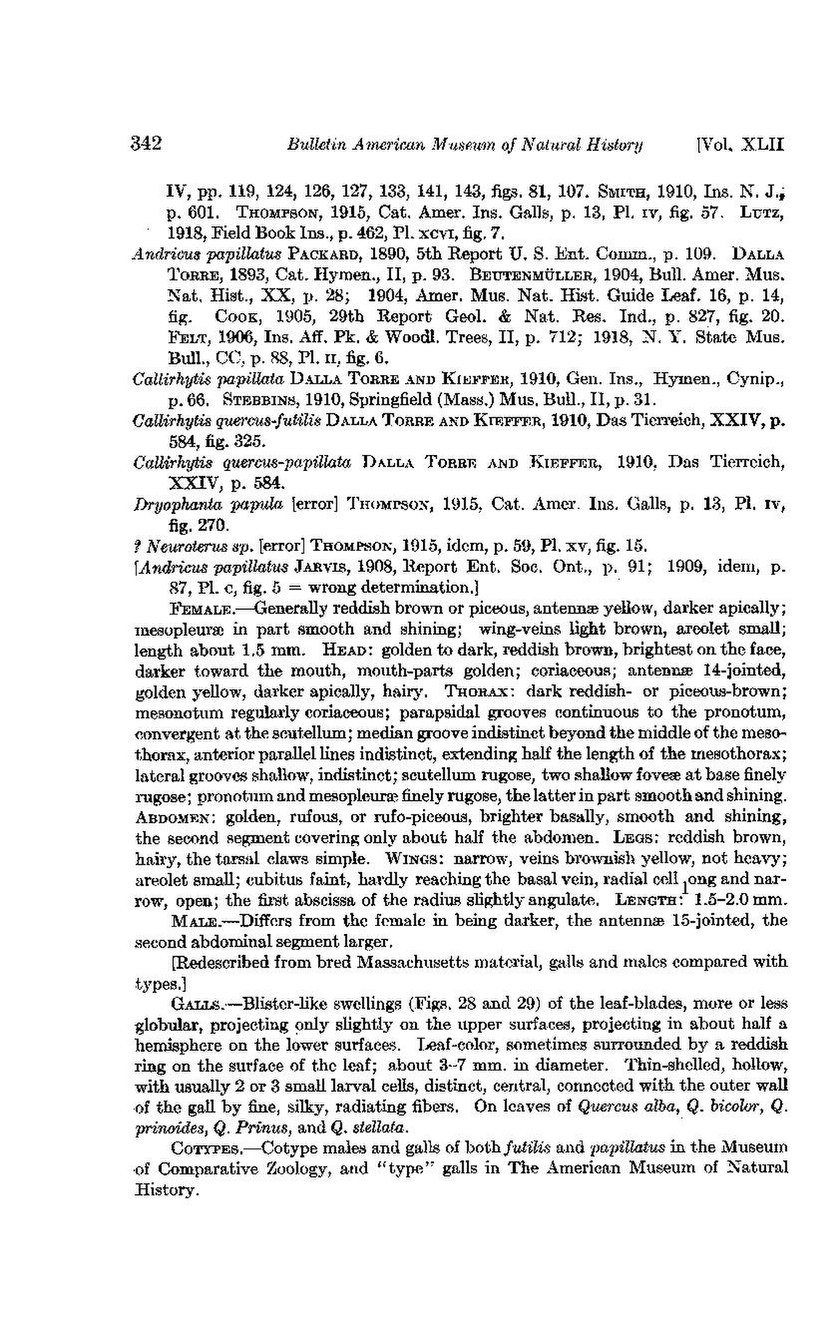IV, pp. 119, 124, 126, 127, 133, 141, 143, figs. 81, 107. Smith, 1910, Ins. N. J.,p. 601. Thompson, 1915, Cat. Amer. Ins. Galls, p. 13, P1. iv, fig. 57. Lutz, 1918, Field Book Ins., p. 462, PI. xcvi, fig. 7.
Andricus papillatus Packard, 1890, 5th Report U. S. Ent. Comm., p. 109. Dalla Torre, 1893, Cat. Hymen., II, p. 93. Beutenmüller, 1904, Bull. Amer. Mus. Nat. Hist., XX, p. 28; 1904, Amer. Mus. Nat. Hist. Guide Leaf. 16, p. 14, fig. Cook, 1905, 29th Report Geol. & Nat. Res. Ind., p. 827, fig. 20. Felt, 1906, Ins. Aff. Pk. & Woodl. Trees, II, p. 712; 1918, N. Y. State Mus.Bull., CC, p. 88, P1. ii, fig. 6.
Callirhytis papillata Dalla Torre and Kieffer, 1910, Gen. Ins., Hymen., Cynip., p. 66. Stebbins, 1910, Springfield (Mass.) Mus. Bull., II, p. 31.
Callirhytis quercus-futilis Dalla Torre and Kieffer, 1910, Das Tierreich, XXIV, p. 584, fig. 325.
Callirhytis quercus-papillata Dalla Torre and Kieffer, 1910, Das Tierreich, XXIV, p. 584.
Dryophanta papula [error] Thompson, 1915, Cat. Amer. Ins. Galls, p. 13, P1. iv, fig. 270.
? Neuroterus sp. [error] Thompson, 1915, idem, p. 59, P1. xv, fig. 15.
[Andricus papillatus {{Smallcaps|Jarvis, 1908, Report Ent. Soc. Ont., p. 91; 1909, idem, p. 87, P1. c, fig. 5 = wrong determination.]
Female.—Generally reddish brown or piceous, antenni yellow, darker apically; mesopleure in part smooth and shining; wing-veins light brown, areolet small; length about 1.5 mm. Head: golden to dark, reddish brown, brightest on the face, darker toward the mouth, mouth-parts golden; coriaceous; antennle 14-jointed, golden yellow, darker apically, hairy. Thorax: dark reddish or piceous-brown; mesonotum regularly coriaceous; parapsidal grooves continuous to the pronotum, convergent at the scutellum; median groove indistinct beyond the middle of the mesothorax, anterior parallel lines indistinct, extending half the length of the mesothorax; lateral grooves shallow, indistinct; scutellum rugose, two shallow foveæ at base finely rugose; pronotum and mesopleuræ finely rugose, the latter in part smooth and shining. Abdomen: golden, rufous, or rufo-piceous, brighter basally, smooth and shining, the second segment covering only about half the abdomen. Legs: reddish brown, hairy, the tarsal claws simple. Wings: narrow, veins brownish yellow, not heavy; areolet small; cubitus faint, hardly reaching the basal vein, radial cell Iong and narrow, open; the first abscissa of the radius slightly angulate. Length: 1.5-2.0 mm.
Male.—Differs from the female in being darker, the antennase 15-jointed, the second abdominal segment larger.
[Redescribed from bred Massachusetts material, galls and males compared with types.]
Galls.—Blister-like swellings (Figs. 28 and 29) of the leaf-blades, more or less globular, projecting only slightly on the upper surfaces, projecting in about half a hemisphere on the lower surfaces. Leaf-color, sometimes surrounded by a reddish ring on the surface of the leaf; about 3-7 mm. in diameter. Thin-shelled, hollow, with usually 2 or 3 small larval cells, distinct, central, connected with the outer wall of the gall by fine, silky, radiating fibers. On leaves of Quercus alba, Q. bicolor, Q. prinoides, Q. Prinus, and Q. stellata.
Cotypes.—Cotype males and galls of both futilis and papillatus in the Museum of Comparative Zoology, and "type" galls in The American Museum of Natural History.